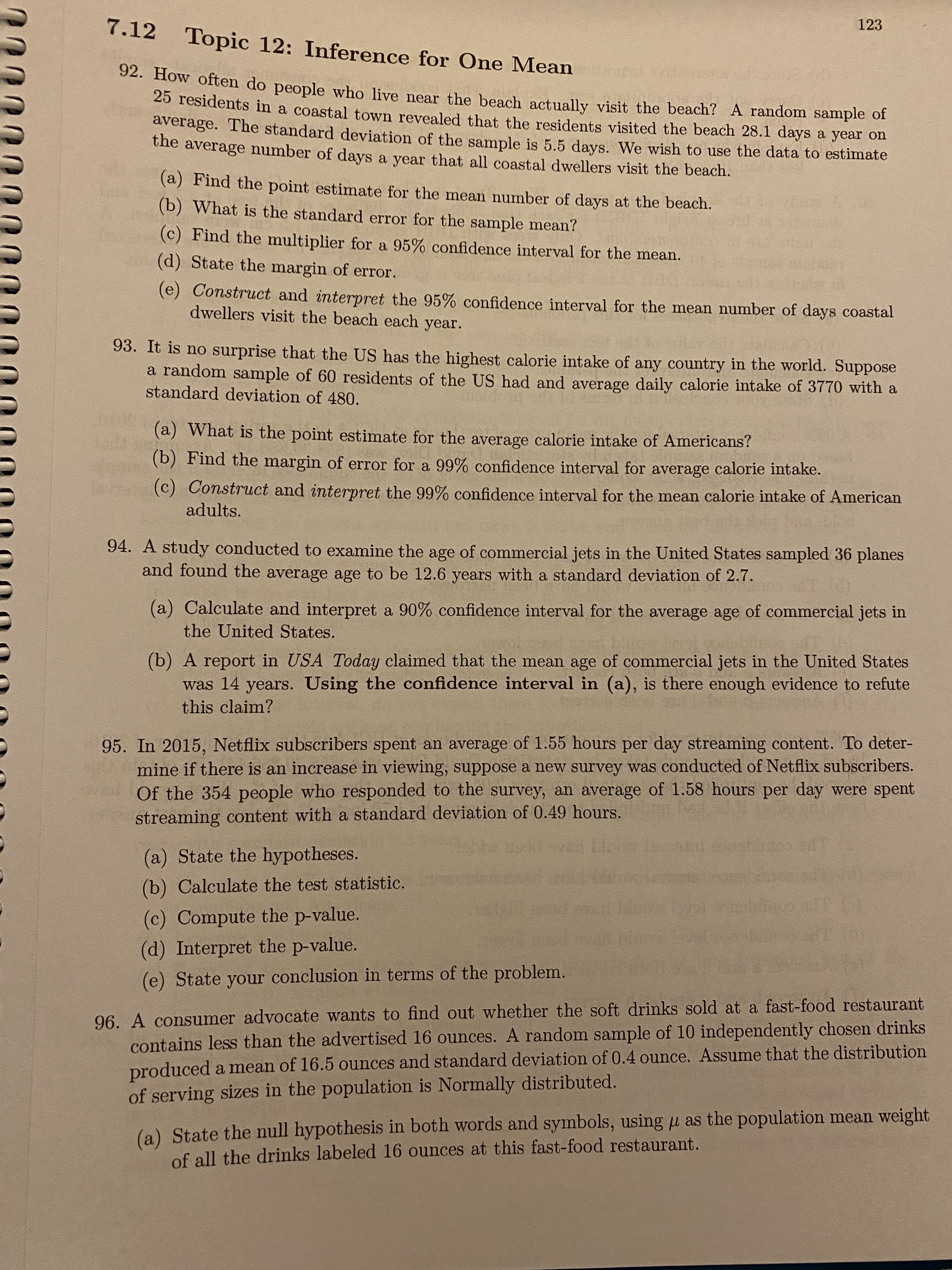7.12 Topic 12: Inference for One Mean 123 92. How often do people who live near the beach actually visit the beach? A random sample of 25 residents in a coastal town revealed that the residents visited the beach 28.1 days a year on average. The standard deviation of the sample is 5.5 days. We wish to use the data to estimate the average number of days a year that all coastal dwellers visit the beach. (a) Find the point estimate for the mean number of days at the beach. (b) What is the standard error for the sample mean? (c) Find the multiplier for a 95% confidence interval for the mean. (d) State the margin of error. (e) Construct and interpret the 95% confidence interval for the mean number of days coastal dwellers visit the beach each year. 93. It is no surprise that the US has the highest calorie intake of any country in the world. Suppose a random sample of 60 residents of the US had and average daily calorie intake of 3770 with a standard deviation of 480. (a) What is the point estimate for the average calorie intake of Americans? (b) Find the margin of error for a 99% confidence interval for average calorie intake. (c) Construct and interpret the 99% confidence interval for the mean calorie intake of American adults. 94. A study conducted to examine the age of commercial jets in the United States sampled 36 planes and found the average age to be 12.6 years with a standard deviation of 2.7. (a) Calculate and interpret a 90% confidence interval for the average age of commercial jets in the United States. (b) A report in USA Today claimed that the mean age of commercial jets in the United States was 14 years. Using the confidence interval in (a), is there enough evidence to refute this claim? 95. In 2015, Netflix subscribers spent an average of 1.55 hours per day streaming content. To deter- mine if there is an increase in viewing, suppose a new survey was conducted of Netflix subscribers. Of the 354 people who responded to the survey, an average of 1.58 hours per day were spent streaming content with a standard deviation of 0.49 hours. (a) State the hypotheses. (b) Calculate the test statistic. (c) Compute the p-value. (d) Interpret the p-value. (e) State your conclusion in terms of the problem. 96. A consumer advocate wants to find out whether the soft drinks sold at a fast-food restaurant contains less than the advertised 16 ounces. A random sample of 10 independently chosen drinks produced a mean of 16.5 ounces and standard deviation of 0.4 ounce. Assume that the distribution of serving sizes in the population is Normally distributed. (a) State the null hypothesis in both words and symbols, using µ as the population mean weight of all the drinks labeled 16 ounces at this fast-food restaurant.
Addition Rule of Probability
It simply refers to the likelihood of an event taking place whenever the occurrence of an event is uncertain. The probability of a single event can be calculated by dividing the number of successful trials of that event by the total number of trials.
Expected Value
When a large number of trials are performed for any random variable ‘X’, the predicted result is most likely the mean of all the outcomes for the random variable and it is known as expected value also known as expectation. The expected value, also known as the expectation, is denoted by: E(X).
Probability Distributions
Understanding probability is necessary to know the probability distributions. In statistics, probability is how the uncertainty of an event is measured. This event can be anything. The most common examples include tossing a coin, rolling a die, or choosing a card. Each of these events has multiple possibilities. Every such possibility is measured with the help of probability. To be more precise, the probability is used for calculating the occurrence of events that may or may not happen. Probability does not give sure results. Unless the probability of any event is 1, the different outcomes may or may not happen in real life, regardless of how less or how more their probability is.
Basic Probability
The simple definition of probability it is a chance of the occurrence of an event. It is defined in numerical form and the probability value is between 0 to 1. The probability value 0 indicates that there is no chance of that event occurring and the probability value 1 indicates that the event will occur. Sum of the probability value must be 1. The probability value is never a negative number. If it happens, then recheck the calculation.
Question 92 part D and E

Trending now
This is a popular solution!
Step by step
Solved in 4 steps


